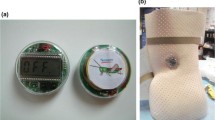Abstract
There is considerable controversy regarding the effectiveness of orthotic treatment for patients with adolescent idiopathic scoliosis. Most researchers believe that, to be effective, the orthosis must be worn as prescribed for both compliance and tightness. Compliance is the time the brace is worn relative to the prescribed time. A battery-powered microcomputer system was developed to monitor and maintain the loads exerted by orthoses used to treat children with spinal deformities during daily living. This system not only records how well and for how much time the brace has been used, but also helps patients to ensure that the brace is being worn at the prescribed tightness. Laboratory tests were performed, and five patients used the system for four weeks. The patients reported that the system helped them to wear the orthoses correctly and comfortably. The time that the patients wore the orthoses at the prescribed tightness level increased from 53±9% during the monitoring period (first 2 weeks) to 68±14% during the automatic adjustment period (last 2 weeks).
Similar content being viewed by others
References
Emans, J. B., Kaelin, A., Bancel, P., Hall, J. E., andMiller, M. E. (1986): ‘The Boston brace system for idiopathic scoliosis-follow-up results in 295 patients’,Spine,11, pp. 792–801.
Fernandez-Feliberti, R., Flynn, J., Ramirez, N., Trautmann, M., andAlegria, M. (1995): ‘Effectiveness of TLSO bracing in the conservative treatment of idiopathic scoliosis’,J. Pediatr. Orthop. 15, pp. 176–181.
Goldberg, C. J., Moore, D. P., Fograrty, E. E., andDowling F. E. (2001): ‘Adolescent idiopathic scoliosis: the effect of brace treatment on the incidence of surgery,’Spine,26, pp. 42–47.
Havey, R., Gavin, T., Patwardhan, A., Pawelczak, S., Ibrahim, K., Andersson, G. andLavender, S. (2002): ‘A reliable and accurate method for measuring orthosis wearing time’,Spine,27, pp. 211–214.
Karol, L. A. (2001): ‘Effectiveness of bracing in male patients with idiopathic scoliosis’,Spine,26, pp. 2001–2005.
Jiang, H., Raso, V. J, Hill, D. L., Durdle, N. G., andMoreau, M. (1992): ‘Interface pressures in the Boston brace treatment for scoliosis’ Proc. Int. Symposium on 3-D Scoliotic Deformites, Montreal, 27–30 June, pp. 395–399.
Lavell, J. R., Smith, K., Platts, R., Morley, T. R., Ransford, A. O., andEdgar, M. A. (1996): ‘An assessment of brace compliance in adolescent idiopathic scoliosis using a new brace timer’, Proc. Br. Scolios. Soc.,J. Bone Joint. Surg.,78B, p. 162
Lavell, J. R. Edgar, M. A., Ransford, A. O., Morley, T. R., andSmith, K. (1997): ‘Do scolisois patients wear their braces?’ Proc. Br. Scolios. Soc.,J. Bone Joint. Surg.,79B, p. 322.
Lonstein, J. E., andWinter, R. B. (1994): ‘The Milwaukee brace for the treatment of adolescent idiopathic scoliosis. A review of one thousand and twenty patients’,J. Bone Joint. Surg. Am.,76, pp. 1207–1221.
Lou, E., Raso, V. J., Hill, D. L., Durdle, N. G., Mahood, J. K., andMoreau, M. J. (2002): ‘The daily force pattern of spinal orthoses in subject with adolescent idiopathic scoliosis,’Prosthet. Ortho. Int. 26, pp. 58–63.
Lou, E., Raso, V. J., Hill, D. L., Durdle, N. G., Mahood, J. K., andMoreau, M. J. (2004a): ‘Correlation between quantity and quality of orthosis wear and treatment outcomes in AIS’,Prosthet. Orthot. Int. J.,28, pp. 49–54
Lou, E., Venkateswaran, S., Hill, D. L., Raso, V. J., andDonauer, A (2004b): ‘An intelligent active brace system for the treatment of scoliosis’,IEEE Trans. Instrument. Meas.,53, pp. 1146–1151
Nicholson, G., Ferguson-Pell, M., Smith, K., Edgar, M., andMorley, T. (2001): ‘Development of instrumented spinal brace for measuring compliance and skin microclimate in the conservative treatment of adolescent idiopathic scoliosis’, Proc. of British Scoliosis Society, Silver Jubilee Meeting, March 7–9, p. 17.
Rowe, D. E., Bernstein, S. M., Riddick, M. F., Adler, F., Emans, J. B., andGardner-Bonneau, D. (1997): ‘A meta-analysis of the efficacy of non-operative treatments for idiopathic scoliosis’,J. Bone Joint Surg. Am. 79, pp. 664–674
Scoliosis Research Society (SRS), [SRS Patient Information web site]. Available at: http:www.srs.org./index.htm Accessed October 29, 2001
Wong, M. S., Mak, A. F., Luk, K. D., Evans, J. H., andBrown B. (2000): ‘Effectiveness and biomechanics of spinal orthoses in the treatment of adolescent idiopathic scoliosis (AIS)’,Prosthet. Orthot. Int.,24, pp. 148–162.
Author information
Authors and Affiliations
Corresponding author
Rights and permissions
About this article
Cite this article
Lou, E., Hill, D.L., Raso, J.V. et al. Smart orthosis for the treatment of adolescent idiopathic scoliosis. Med. Biol. Eng. Comput. 43, 746–750 (2005). https://doi.org/10.1007/BF02430952
Received:
Accepted:
Issue Date:
DOI: https://doi.org/10.1007/BF02430952




